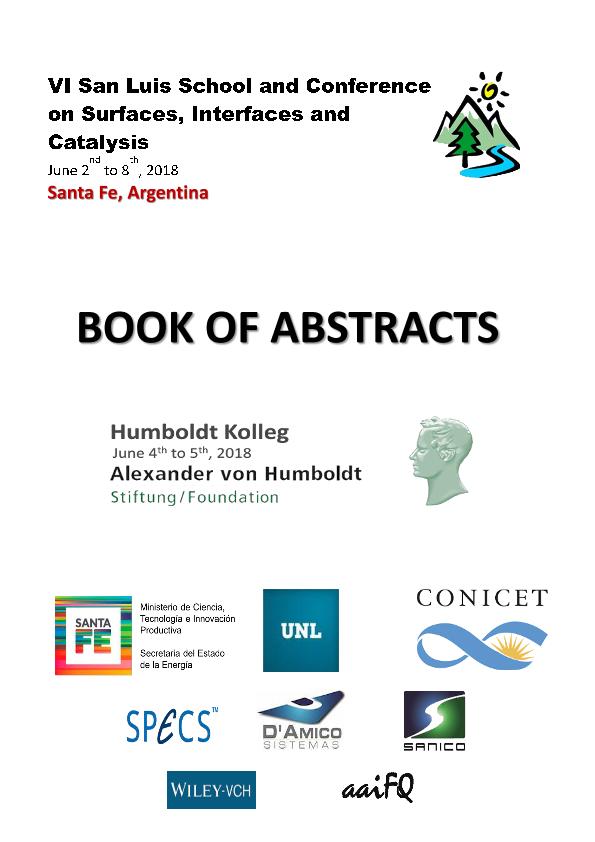Mostrar el registro sencillo del ítem
dc.contributor.author
Morgade, Cecilia Ines Nora

dc.contributor.author
Cabeza, Gabriela Fernanda

dc.date.available
2022-04-07T14:16:04Z
dc.date.issued
2019
dc.identifier.citation
Theoretical study on the electronic and catalytic properties of Fe-doped TiO2 and its use in the removal of arsenic; VI San Luis School and Conference on Surfaces, Interfaces and Catalysis; Santa Fe; Argentina; 2018; 132-132
dc.identifier.uri
http://hdl.handle.net/11336/154587
dc.description.abstract
Arsenic (As) is atoxic element that can be fatal to humans. In the environment, it exists indifferent oxidation states (-III, 0, + III and + V). However, in natural water,the As is mainly found in inorganic form forming as oxyanions of trivalentarsenite As (III) or pentavalent arsenate As (V) depending on the redoxpotential and the pH of the water. The contamination of water with arsenic is aglobal problem related mainly to its extensive presence in water resources usedfor human consumption1. Arsenate is more stable, less mobile andtoxic than As (III) and more efficiently removed from water. Therefore, commonmethods for the removal of arsenic from water involve the oxidation of the As(III) to As (V) species. As an alternative to conventional procedures,different proposals have attracted considerable attention in recent years,including heterogeneous photocatalysis with titanium dioxide (TiO2)and the use of zero valent iron (Fe0) known as ZVI. At present, two experimental studies can be mentioned,a recent one by López-Muñoz2 and another study by Nguyen et al. informing the use ofphotocatalysis with TiO2and ZVI nanoparticles (NP-ZVI) for the removal of As (III) from aqueous systems3.The results obtained demonstrated an increase in the arsenic removal efficiencyof the aqueous solution when ZVI particles were added to the reactor. As photocatalysis with both systems pure TiO2and in combination with iron offer attractive advantages for the treatment ofarsenic in aqueous systems, it is interesting to compare their performance andexplore the potential synergism between them. That is why in this work bothsystems were modeled with the objective of determining the mainphysical-chemical parameters that control the activity and selectivity towardsthe oxidation of arsenic (As). The calculations were made using the VASP4code within the formalism of the Functional Density theory, with the inclusionof the Hubbard coefficient (DFT + U). The chosen surfaces of the titania are thecatalytically most active, anatase TiO2(101) and rutile TiO2(110). The As/TiO2 interaction was modeled by depositing 1, 2 or 4As0 atoms. Different Fe-doping options (cationic and interstitial)were studied. The As adsorption energies were calculated on both surfaces. The study is completed with the analysis of the adsorption of different arsenious species.
dc.format
application/pdf
dc.language.iso
eng
dc.publisher
Universidad Nacional del Litoral
dc.rights
info:eu-repo/semantics/openAccess
dc.rights.uri
https://creativecommons.org/licenses/by-nc-sa/2.5/ar/
dc.subject
TITANIA
dc.subject
DFT
dc.subject
ARSENIC
dc.subject
IRON
dc.subject.classification
Física Atómica, Molecular y Química

dc.subject.classification
Ciencias Físicas

dc.subject.classification
CIENCIAS NATURALES Y EXACTAS

dc.title
Theoretical study on the electronic and catalytic properties of Fe-doped TiO2 and its use in the removal of arsenic
dc.type
info:eu-repo/semantics/publishedVersion
dc.type
info:eu-repo/semantics/conferenceObject
dc.type
info:ar-repo/semantics/documento de conferencia
dc.date.updated
2022-03-16T19:17:31Z
dc.journal.pagination
132-132
dc.journal.pais
Argentina

dc.journal.ciudad
Santa Fe
dc.description.fil
Fil: Morgade, Cecilia Ines Nora. Universidad Tecnológica Nacional. Facultad Regional Bahía Blanca; Argentina. Consejo Nacional de Investigaciones Científicas y Técnicas. Centro Científico Tecnológico Conicet - Bahía Blanca. Instituto de Física del Sur. Universidad Nacional del Sur. Departamento de Física. Instituto de Física del Sur; Argentina
dc.description.fil
Fil: Cabeza, Gabriela Fernanda. Consejo Nacional de Investigaciones Científicas y Técnicas. Centro Científico Tecnológico Conicet - Bahía Blanca. Instituto de Física del Sur. Universidad Nacional del Sur. Departamento de Física. Instituto de Física del Sur; Argentina
dc.relation.alternativeid
info:eu-repo/semantics/altIdentifier/url/https://servicios.intec.santafe-conicet.gov.ar/eventos/sanluisvi/important-information/vi-san-luis-conference/#BOA
dc.conicet.rol
Autor

dc.conicet.rol
Autor

dc.coverage
Internacional
dc.type.subtype
Conferencia
dc.description.nombreEvento
VI San Luis School and Conference on Surfaces, Interfaces and Catalysis
dc.date.evento
2018-06-02
dc.description.ciudadEvento
Santa Fe
dc.description.paisEvento
Argentina

dc.type.publicacion
Book
dc.description.institucionOrganizadora
Consejo Nacional de Investigaciones Científicas y Técnicas. Centro Científico Tecnológico Santa Fé. Instituto de Investigaciones en Catálisis y Petroquímica
dc.description.institucionOrganizadora
Universidad Nacional del Litoral
dc.source.libro
Book of abstracts
dc.date.eventoHasta
2018-06-08
dc.type
Conferencia
Archivos asociados
